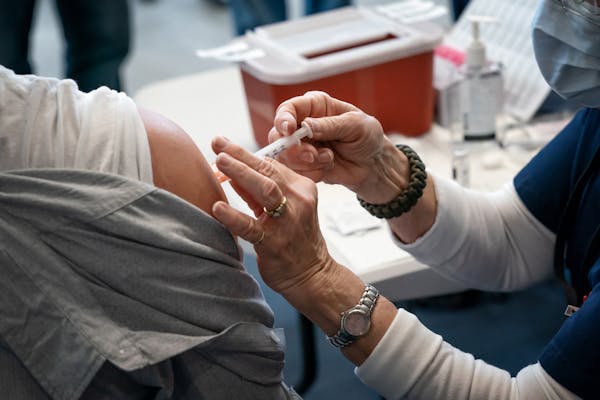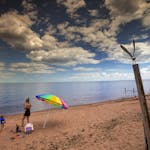Minnesota is making COVID-19 vaccine accessible to the general public for the first time, opening nine sites where shots will be provided by appointment to people 65 or older, and to teachers and child care providers.
Gov. Tim Walz said the expansion is an important first step toward broad public vaccinations of Minnesotans against the novel coronavirus that causes COVID-19, but he urged patience because it makes around 1 million more people eligible for a few thousand available doses.
"Every single one of those doses is one step closer to us getting done with this," Walz said.
Minnesota is slated to receive roughly 60,000 more first doses of the two-dose COVID-19 vaccines this week and is diverting 12,000 to these sites, which will begin to give shots on Thursday by appointment only. Senior citizens can register online, starting at noon Tuesday, but Walz warned that there will be a surge of interest and that "this is going to be harder than going to Ticketmaster and getting Bruce Springsteen tickets."
Educators will be scheduled through their school districts and child-care facilities.
State leaders said the priority remains vaccinating roughly 500,000 Minnesotans who are health care workers, or staff and residents in long-term care facilities, but that progress in that group allows for this next step. The Minnesota Department of Health on Monday reported 194,462 people, or 3.5% of the state population, have received at least first doses and that 38,025 of them have received both doses of the Pfizer or Moderna vaccines.
First doses have been offered or provided at all skilled nursing homes and to all of the highest-priority workers at greatest risk of infection in emergency departments and COVID-19 treatment units, said Kris Ehresmann, state infectious disease director.
Minnesota remains on track to have at least offered vaccine to all health care workers by the end of the month, but Ehresmann said some of their appointments could be pushed to February due to the diversion of doses to this new expansion group.
The abrupt change by the Trump administration last week, encouraging states to consider adding people 65 and older to the top priority list, hastened Minnesota's plans a bit.
"They are still being prioritized," Ehresmann said of health care workers, "but we are in a tough position because there is an expectation now that many, many more people will receive vaccine."
The state expansion should improve Minnesota's performance on key metrics for vaccine administration. Minnesota as of Monday reported using 45.1% of the 516,675 doses that have been shipped to the state. While some of the unused doses are still in transit, others are slotted for vaccine appointments that occur days later.
"The hope is that this will speed up administration of vaccines, and the number of doses administered will go up," Ehresmann said.
Minnesota remains about average for its vaccination rate per 100,000 people, according to the latest data from the U.S. Centers for Disease Control and Prevention.
The Trump administration last week had pledged to start awarding more doses to states with higher vaccination rates, but Walz said he does not expect the incoming Biden administration to follow through on that. Walz said he remained angry with Trump's health and human services secretary, Alex Azar, for promising the release of more doses last week that weren't actually being held in federal reserve.
"I was hoping we were going to get a double allotment this week of 120,000," the governor said.
The new state sites are in Andover, Brooklyn Center, Fergus Falls, Marshall, Mountain Iron, North Mankato, Rochester, St. Cloud and Thief River Falls. Walz said these sites should demonstrate to the federal government that Minnesota is ready to increase vaccinations.
HealthPartners' Chief Executive Andrea Walsh joined the governor in announcing the move, noting that her Bloomington-based health system has the capacity to use the number of doses it receives each week in one day.
"[People] want access to vaccine now," she said, "and we want to be able to provide it to them."
The federal Advisory Committee on Immunization Practices recommended the second priority group for vaccination to consist of people 75 and older and workers in key front-line industries. The Walz announcement is only a limited expansion into the occupational group, which also includes utility crews and police officers.
Even among educators, the initial opportunities for vaccinations will be small and prioritized for elementary or other teachers doing in-person instruction. The entire St. Paul Public Schools district has access to 88 vaccinations this week, while the New Prague School District received 10.
New Prague High School physics and chemistry teacher John Novak called the amount "laughable," but then added, "I guess I'm glad we got 10."
Bob Egan of Lakeville was upset by the expansion beyond the original priority group of people 75 and older, who have suffered 6% of diagnosed COVID-19 cases but 73% of the deaths.
"I am 82 and have a brother at 84 and a sister at 87," Egan said. "We are of course anxiously waiting to get this vaccine, and yes we are disappointed that now we will have to compete" with the broader group.
State health officials have called vaccinations the endgame to a pandemic that has caused 447,349 diagnosed infections and resulted in hospitalizations for 23,428 Minnesotans. The latest tallies include 12 deaths — bringing the state's total to 5,939 — and 980 infections reported on Monday.
State Health Commissioner Jan Malcolm urged the federal government to release more available vaccine doses to states because the rationing of limited doses will cause frustration for those who must wait. She discouraged people wanting vaccine from seeking access through their doctors, noting that the online appointment system is the only means for now.
While other COVID-19 vaccines are nearing federal approval, Malcolm said Minnesota is still months away from open public access to vaccine in retail pharmacies and clinics.
"We estimate it will take about four and a half months at the current pace of doses that we're getting from the federal government," she said, "to get through this newly eligible set of Minnesotans."
Jeremy Olson • 612-673-7744





